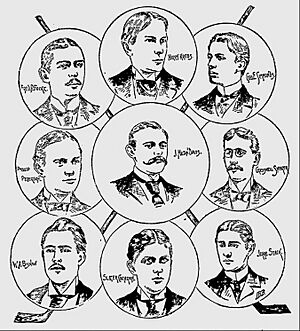Cresswell Shearer facts for kids
Quick facts for kids
Cresswell Shearer
|
|
|---|---|
| Born | May 24, 1874 |
| Died | February 6, 1941 (aged 66) |
| Awards | Fellow of the Royal Society |
| Scientific career | |
| Institutions | University of Cambridge, McGill University, Johns Hopkins University, Stazione Zoologica |

Cresswell Shearer (born May 24, 1874 – died February 6, 1941) was a British zoologist. He taught at the University of Cambridge, focusing on how living things develop. He loved to inspire his students to do hands-on research.
He often invited them to spend summers at the Marine Biological Association lab in Plymouth, England. There, they could study marine life up close. Cresswell Shearer was a pioneer in studying sea urchin larvae. He worked with Dorothy Jordan Lloyd to figure out how to grow these larvae without fertilization. This process is called parthenogenesis. He also researched sea urchin genetics with Harold Munro Fox.
During World War I, Cresswell used his medical skills at a military hospital. He helped improve ways to study a germ called meningococcus. This germ caused serious infections like meningitis. Besides science, he loved photography and Italian architecture. He even published a book about architecture in 1935.
Contents
Education and Early Career
Cresswell Shearer first studied zoology and biology at Johns Hopkins University. He then returned to Canada to earn a medical degree. He graduated from McGill University in 1901.
After graduating, Shearer began his career as a zoologist. He worked at the biological laboratory at McGill. From 1903 to 1909, he developed his interest in experimental embryology. This is the study of how embryos grow and develop. He did this research at the Stazione Zoologica Anton Dohrn in Italy.
Life at Cambridge
In 1910, Cresswell Shearer settled in Cambridge, England. He became a lecturer in experimental embryology. When World War I started in 1914, he was in Plymouth. He decided to use his medical training to help the troops. He worked at Davenport Military Hospital. While there, he made important discoveries about studying meningococcus germs. He found that nasal secretions and vitamins could help grow samples of these germs.
After the war, he returned to Cambridge. He moved from the Zoology Department to the Anatomy Department. Embryology was a new subject there. He taught until he retired in 1937. After retirement, he went back to the Zoology Department to continue his research.
Awards and Recognition
Cresswell Shearer received several important awards for his work:
- In 1912, he was chosen for the Harding Lectureship. This award recognized his work in developing new areas of biological science.
- In 1916, he was elected a Fellow of the Royal Society. This is a very high honor for scientists in the United Kingdom.
Family Life
Cresswell Shearer met his wife while working as a medic during World War I. They met in Plymouth. They had two sons together. His niece was the famous actress Norma Shearer.
Published Works
Cresswell Shearer published a book about architecture. It was called The Renaissance of Architecture in Southern Italy. This book explored the architecture of Frederick II of Hohenstaufen. It also looked at the Capua Triumphator archway and towers.
He also published many scientific papers. These papers covered his research on topics like nerve endings, malaria parasites, and sea urchin development.

